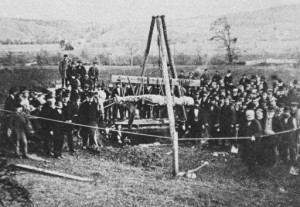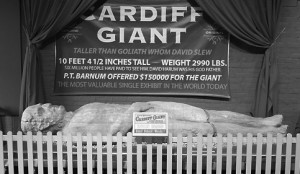In 1869 in two men digging a well came across at ten foot tall stone man in rural New York. Immediately the find was claimed to be alternately an example of the Biblical giants from Genesis 6:4 or an ancient statue carved by a long gone tribe. In fact it was neither of these it had been created by an atheist tobacconist named George Hull. He was inspired and enraged by a conversation with a biblical literalist reverend he met in Iowa. Hull acquired a 5 ton block of Gypsum and swore multiple people to secrecy along the way as he got the man carved and buried on the farm of William Newell in Cardiff New York.
Newell began to display the artifact now known as the “Cardiff Giant” under a tent on his farm and charging fifty cents for people to come look at it, and he made a killing with this. American’s traveled from across the eastern seaboard to see this remnant of some sort of ancient past. This was the Burned Over District during the Second Great Awakening which meant that the Cardiff Giant was discovered in a time and place there was an immense amount of religious seeking and thus the idea of physical evidence of an ancient Biblical past on American soil was enthusiastically received by the general public. It’s not so different from the beginnings of Mormonism.
The Giant was soon exposed as a hoax and yet people continued to visit it in its new home in Syracuse. And P.T. Barnum even offered to lease it for 3 months for $60,000 and when he could not get it he built his own replica to travel with his circus. The Giant now resides in the Farmer’s Museum in Cooperstown, New York where people still visit it today.
The Cardiff Giant is an example of groups of people building a cultural identity around an “archaeological” find. Fundamentalist Christians wanted to validate their faith and their connection to a Christian past in America to legitimize the colonization of America. And if this giant man was really a petrified body of a biblical giant no one could deny that Christianity and, by the logic, Europeans had a right to be in the Americas.
But even when the truth was revealed and the Cardiff Giant was clearly not an actual archaeological artifact people continued to be fascinated by it, and in this way we can see something about America today. We are interested in how we see our pasts and the Cardiff Giant is now a ridiculous example of how easily people could be hoaxed in the past. We like to think we have e come farther and that we are better at validating our artifacts but fraud in archaeology is still prevalent and it is estimated that over 1200 fake artifacts are on display in major museums, so honestly we cannot say that we have gotten much better as a society at collectively recognizing hoaxes. Or maybe the hoaxers have just gotten better.
Bibliography
“Cardiff Giant, Cooperstown, New York.” RoadsideAmerica.com. Web. 10 Nov. 2014. .
Renfrew, Colin, and Paul Bahn. Archaeology Essentials. 2nd ed. London: Thames & Hudson, 2010. Print.
“The Cardiff Giant.” The Farmers’ Museum. Web. 10 Nov. 2014. .
“The Littlest Literary Hoax.” Museum of Hoaxes. Web. 10 Nov. 2014.

